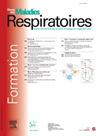Chronic ozone induces lung inflammation through NLRP6-dependent activation of pyroptosis pathways in pneumocytes
IF 0.5
4区 医学
Q4 RESPIRATORY SYSTEM
引用次数: 0
Abstract
Introduction
Environmental air pollutants including ozone cause severe lung injury and aggravate respiratory diseases such as asthma and COPD. Ozone is a major air pollutant causing pulmonary inflammation evolving into lung emphysema and/or fibrosis in mice exposed to ozone but the mechanisms are not well understood. Innate immune sensors such as nucleotide-oligomerization domain-like receptors (NLRs) are able to form cytosolic complexes named inflammasomes that mediate inflammatory cytokines production and immunological cell death. Among NLRs, NLRP3 was shown to be involved in establishment of lung inflammation to ozone. However, the role of NLRP6, another NLR in involved in inflammasome scaffold, like NLRP6 in ozone-induced lung pathologies is unknown.
Methods
Using a 6 weeks model of chronic ozone exposure in mice, we explored the role of the innate receptor NLRP6 in the context of immunological cell death, in ozone exposure-associated pulmonary inflammation.
Results
We found that Nlrp6 deficiency dampens airway and lung inflammation with reduced neutrophils, eosinophils influx and production of associated chemokines/cytokines including Th2 response, remodeling factor production, collagen deposition and fibrosis in response to chronic ozone exposure. Interestingly, we observed increased NLRP6 expression in bronchial epithelial cells, pneumocytes and infiltrating macrophages in lung tissue and airway macrophages upon chronic ozone exposure. Mechanistically, we report that chronic ozone promotes NLRP6-mediated caspase-1- and caspase11-dependent gasdermin D activation in alveolar type 1 pneumocytes suggesting NLRP6 inflammasome drives lung inflammation. Moreover, gasdermin D deficiency leads to reduced pulmonary inflammation after chronic ozone exposure. Mice deficient for NLRP6 in alveolar epithelial cells display reduced inflammation with impaired caspase-1/11 and gasdermin D activation in lungs, which confirms NLRP6-driven inflammation in these cells. Finally, we found that caspase-3Casp3/8 and gasdermin E activation depends on NLRPlrp6.
Conclusion
In conclusion we provide the first evidence that NLRP6 is a key player in chronic ozone pulmonary inflammation associated with the induction of both gasdermin-D and gasdermin E-dependent pyroptosisimmunogenic cell death.
慢性臭氧通过nlrp6依赖性激活肺细胞的焦亡途径诱导肺部炎症
包括臭氧在内的环境空气污染物会造成严重的肺损伤,加重哮喘和慢性阻塞性肺病等呼吸系统疾病。臭氧是一种主要的空气污染物,可导致暴露于臭氧的小鼠肺部炎症演变为肺气肿和/或纤维化,但其机制尚不清楚。先天免疫传感器如核苷酸寡聚化结构域样受体(NLRs)能够形成称为炎症小体的细胞质复合物,介导炎症细胞因子的产生和免疫细胞死亡。在nlr中,NLRP3被证明参与了肺部对臭氧的炎症的建立。然而,与NLRP6一样,另一种参与炎性小体支架的NLRP6在臭氧诱导的肺部病变中的作用尚不清楚。方法利用小鼠慢性臭氧暴露6周的模型,我们探讨了先天受体NLRP6在臭氧暴露相关肺部炎症中免疫细胞死亡的作用。结果我们发现Nlrp6缺乏可抑制气道和肺部炎症,减少中性粒细胞、嗜酸性粒细胞内流和相关趋化因子/细胞因子的产生,包括Th2反应、重塑因子产生、胶原沉积和纤维化。有趣的是,我们观察到慢性臭氧暴露后支气管上皮细胞、肺细胞、肺组织浸润性巨噬细胞和气道巨噬细胞中NLRP6的表达增加。在机制上,我们报道了慢性臭氧促进NLRP6介导的caspase-1-和caspase11依赖的肺泡1型肺细胞的气皮蛋白D激活,这表明NLRP6炎症小体驱动肺部炎症。此外,气真皮蛋白D缺乏导致慢性臭氧暴露后肺部炎症减少。肺泡上皮细胞缺乏NLRP6的小鼠表现出炎症减少,肺部caspase-1/11和gasdermin D激活受损,这证实了NLRP6驱动的炎症在这些细胞中发生。最后,我们发现caspase-3Casp3/8和gasdermin E的激活依赖于NLRPlrp6。结论本研究首次证实NLRP6在慢性臭氧肺炎症中起关键作用,与诱导气凝胶蛋白d和气凝胶蛋白e依赖的热致免疫细胞死亡有关。
本文章由计算机程序翻译,如有差异,请以英文原文为准。
求助全文
约1分钟内获得全文
求助全文
来源期刊

Revue des maladies respiratoires
医学-呼吸系统
CiteScore
1.10
自引率
16.70%
发文量
168
审稿时长
4-8 weeks
期刊介绍:
La Revue des Maladies Respiratoires est l''organe officiel d''expression scientifique de la Société de Pneumologie de Langue Française (SPLF). Il s''agit d''un média professionnel francophone, à vocation internationale et accessible ici.
La Revue des Maladies Respiratoires est un outil de formation professionnelle post-universitaire pour l''ensemble de la communauté pneumologique francophone. Elle publie sur son site différentes variétés d''articles scientifiques concernant la Pneumologie :
- Editoriaux,
- Articles originaux,
- Revues générales,
- Articles de synthèses,
- Recommandations d''experts et textes de consensus,
- Séries thématiques,
- Cas cliniques,
- Articles « images et diagnostics »,
- Fiches techniques,
- Lettres à la rédaction.
 求助内容:
求助内容: 应助结果提醒方式:
应助结果提醒方式:


